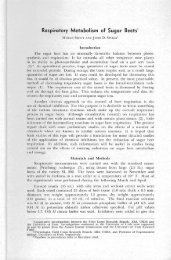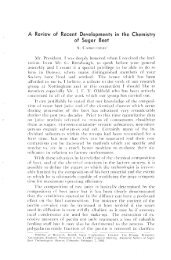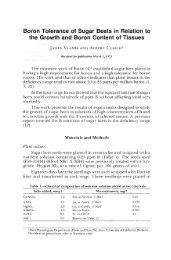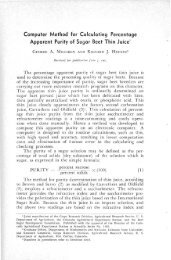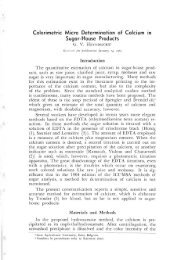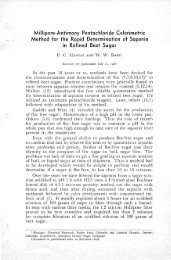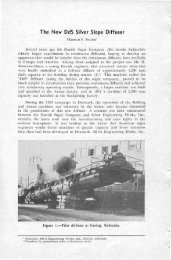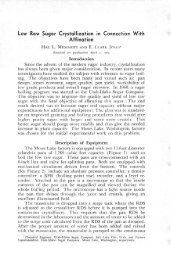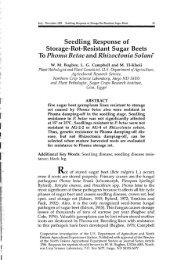Journal of Sugar Beet Research - Vol
Journal of Sugar Beet Research - Vol
Journal of Sugar Beet Research - Vol
You also want an ePaper? Increase the reach of your titles
YUMPU automatically turns print PDFs into web optimized ePapers that Google loves.
44 <strong>Journal</strong> <strong>of</strong> <strong>Sugar</strong> <strong>Beet</strong> <strong>Research</strong> <strong>Vol</strong>. 45 Nos. 1 & 2<br />
which is a systemic insecticide seed treatment that provides control <strong>of</strong><br />
beet leafhoppers (vector for BSCTV) and subsequent reduction in curly<br />
top (Strausbaugh et al., 2006). The beta-cyfluthrin component is a nonsystemic<br />
insecticide that should have had no influence on beet leafhoppers<br />
or curly top. Although Poncho Beta reduces curly top symptoms,<br />
the plants still become infected and some symptom development occurs<br />
even with the most resistant commercial cultivars. Thus, the storage<br />
data presented represent a comparison between more symptomatic and<br />
less symptomatic plants.<br />
The influence <strong>of</strong> disease problems in the field on the ability <strong>of</strong> sugarbeet<br />
tissue to resist freezing is poorly studied. A previous study with<br />
roots from a rhizomania infested field showed that <strong>Beet</strong> necrotic yellow<br />
vein virus could lead to considerable freeze damage (Strausbaugh et al.,<br />
2008). Curly top seemed to have relatively little influence on the risk <strong>of</strong><br />
roots freezing as there were no consistent differences in the data shown<br />
in Table 3. In December 2005 and January 2006 there was freeze damage<br />
but subsequent sampling data revealed very little damage. The risk<br />
<strong>of</strong> roots freezing in relation to curly top infection in the field may not<br />
need to be investigated further.<br />
Curly top in sugarbeet is a widespread important disease problem in<br />
semi-arid areas <strong>of</strong> the western United States from Nebraska to California.<br />
Curly top almost eliminated sugarbeet production until resistance was<br />
incorporated into commercial cultivars (Bennet, 1971). The primary<br />
control measure for curly top is host resistance. However, even the most<br />
resistant commercial cultivars allow for considerable disease development<br />
(Strausbaugh et al., 2007). Seed treatments such as Poncho Beta<br />
reduce curly top damage, but should be viewed as a supplement to<br />
host resistance and not a substitute for host resistance (Strausbaugh et<br />
al., 2006). Even combining our best host resistance with insecticide<br />
seed treatments does not eliminate virus from the plants, leaving room<br />
for further improvement to both host resistance and control measures.<br />
The storage data indicate Poncho Beta also has the potential to reduce<br />
storage losses in roots stored for more than 100 days in storage. <strong>Sugar</strong><br />
companies that store sugarbeet roots need to take into consideration the<br />
influence that cultivar selection can have on sucrose losses. Companies<br />
operating in areas with curly top and long-term storage need to encourage<br />
the use <strong>of</strong> systemic insecticides as seed treatments to reduce or<br />
minimize sucrose loss in storage.



